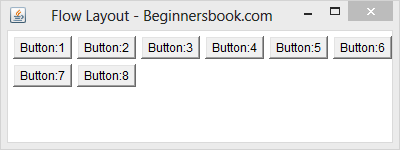

JTextField tf = new JTextField(10) // accepts upto 10 characters JPanel panel = new JPanel() // the panel is not visible in output Creating the panel at bottom and adding components JMenuItem m22 = new JMenuItem("Save as") Creating the MenuBar and adding components even if you are working with just swings. Usually you will require both swing and awt packages
#Flowlayout java stackoverflow code
Try to code yourself before looking at the program below. How about creating a chat frame like below? It aligns components by placing them within a grid of cells, allowing components to span more than one cell.

It is the more sophisticated of all layouts. It simply lays out components in a single row one after the other. It is the default layout manager for every java JFrameįlowLayout is the default layout manager for every JPanel. There are many layout managers, but the most frequently used are- Java BorderLayoutĪ BorderLayout places components in up to five areas: top, bottom, left, right, and center. The Layout manager is used to layout (or arrange) the GUI Java components inside a container. Unexpected output =? Buttons are getting overlapped.

Next, Save, Compile, and Run the program. JButton button2 = new JButton("Button 2") JButton button1 = new JButton("Button 1") How about adding two buttons? Copy the following code into an editor. Copy following code into an editor from given Java UI Example import javax.swing.* Step 3) Copy following code into an editor Next step, Save, Compile, and Run the code JFrame frame = new JFrame("My First GUI") įtDefaultCloseOperation(JFrame.EXIT_ON_CLOSE) įrame.getContentPane().add(button) // Adds Button to content pane of frame In first step Copy the following code into an editor.
#Flowlayout java stackoverflow how to
Now in this Java GUI Tutorial, let’s understand how to create a GUI in Java with Swings in Java examples. The mainpanel layout is set using: tLayout (flowlayout) I then added childpanel to mainpanel : mainpanel.add (childpanel) The childpanel gets added to mainpanel but its position is at the cross-section of horizontal midpoint and top. GUI plays an important role to build easy interfaces for Java applications. through which the user can interact with an application. It is mainly made of graphical components like buttons, labels, windows, etc. GUI (Graphical User Interface) in Java is an easy-to-use visual experience builder for Java applications. In this Java Swing tutorial, you will learn Java GUI basics like-Īll components in Java Swing are JComponent which can be added to container classes. The scroll pane is set with VERTICALSCROLLBARALWAYS and HORIZONTALSCROLLBARNEVER policies. You can use the Java simple GUI programming components like button, textbox, etc., from the library and do not have to create the components from scratch. Java's FlowLayout does not resize correctly I created a JFrame initialized with a BorderLayout and a JScrollPane as its CENTER element. The Java Swing library is built on top of the Java Abstract Widget Toolkit ( AWT), an older, platform dependent GUI toolkit. Swing is a part of Java Foundation Classes(JFC), which is an API for Java GUI programing that provide GUI. Swing provides a rich set of widgets and packages to make sophisticated GUI components for Java applications. JButton buttonCenterCamera = new JButton(positionCameraAction) ītHideActionText( true ) īuttonCenterTool = new JButton(positionToolAction) ītHideActionText( true ) īuttonCenterToolNoSafeZ = new JButton(positionToolNoSafeZAction) īuttonCenterToolNoSafeZ.Swing in Java is a Graphical User Interface (GUI) toolkit that includes the GUI components. Public LocationButtonsPanel(JTextField textFieldX, JTextField textFieldY, JTextField textFieldZ,įlowLayout flowLayout = (FlowLayout) getLayout() īuttonCaptureCamera = new JButton(captureCameraCoordinatesAction) ītHideActionText( true ) īuttonCaptureTool = new JButton(captureToolCoordinatesAction) ītHideActionText( true )


 0 kommentar(er)
0 kommentar(er)
